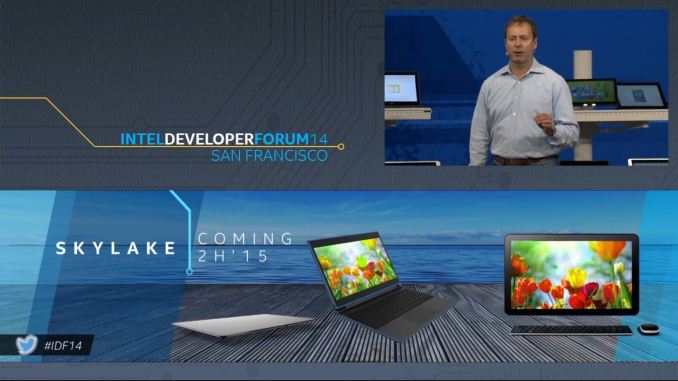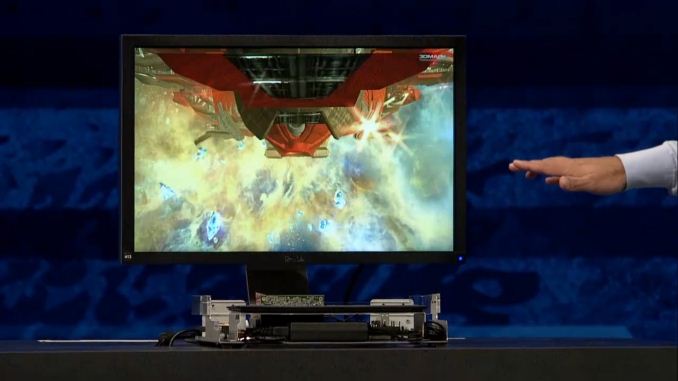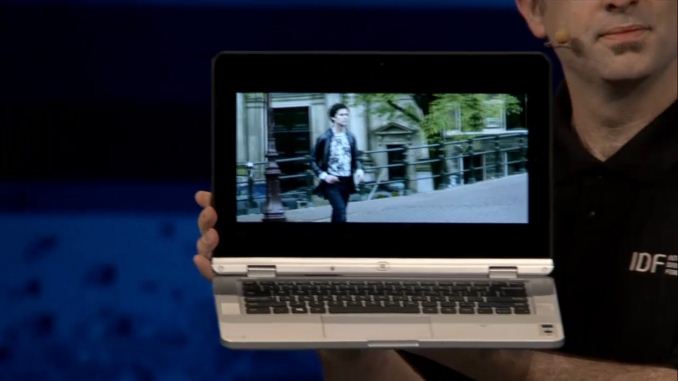IDF 2014: Intel Demonstrates Skylake, Due H2’2015
by Ryan Smith on September 9, 2014 7:30 PM EST
Taking place this week alongside the consumer electronics clamor is the annual Intel Developer Forum (IDF) at the Moscone Center in San Francisco. Though it has and continues to be first and foremost a developers conference, IDF also offers Intel a chance to unveil new products, and in more recent editions discuss and promote their plans for further breaking into the mobile market.
Diving right into the subject of Intel’s Core microarchitecture, with the Broadwell based Core M already in the process of launching, Intel is giving developers and the public a look at what comes after Broadwell. Already on Intel’s roadmaps for some time, Intel took to the stage at IDF14 to formally announce their next-generation Skylake architecture and to demonstrate its status.
| Intel's Tick-Tock Cadence | |||||
| Microarchitecture | Process Node | Tick or Tock | Release Year | ||
| Conroe/Merom | 65nm | Tock | 2006 | ||
| Penryn | 45nm | Tick | 2007 | ||
| Nehalem | 45nm | Tock | 2008 | ||
| Westmere | 32nm | Tick | 2010 | ||
| Sandy Bridge | 32nm | Tock | 2011 | ||
| Ivy Bridge | 22nm | Tick | 2012 | ||
| Haswell | 22nm | Tock | 2013 | ||
| Broadwell | 14nm | Tick | 2014 | ||
| Skylake | 14nm | Tock | 2015 | ||
In Intel terminology Skylake is the Tock to Broadwell’s Tick, offering a new microarchitecture atop the 14nm process first introduced with Broadwell. As is the case with every Core update, for Skylake Intel is shooting for significant increases in performance, power efficiency, and battery life. Since Skylake is built on the same 14nm process as Broadwell, Skylake is primarily an exercise in Intel’s architecture development capabilities, with its gains needing to come from optimizations in design rather than significant manufacturing improvements.
At roughly a year out from launch Intel is not saying anything about the architecture or design at this time, but they are using IDF to showcase that Skylake is up and running. Demonstrating this, Intel showcased a pair of Skylake development systems. The first of which was a traditional open laboratory testbed that was running 3DMark, which was being used to showcase that the GPU and CPU portions of Skylake were running and performing well. The second demonstration was a completed laptop that was playing back 4K video, and is an early version of the hardware Intel will be shipping as the software development vehicle for developers next year.
Alongside their demonstration, Intel also announced a rough timeline for the volume production and availability of Skylake. Volume production will take place in H2’2015, with product availability slated for later in the year. With Broadwell being behind schedule due to a slower than planned bring-up of their 14nm process, there has been some question over what would happen with Skylake and Intel clearly wanted to address this head-on.
Consequently a big part of Intel’s message on Skylake is that the next generation CPU is already up and running and is in a healthy state, apparently unfazed by the earlier 14nm delays that dogged Broadwell. At the same time the H2’2015 launch date for Skylake means that it’s going to be out roughly a year after the first Broadwell parts, which means Intel still intends to adhere to their roughly 1 year product replacement cadence.












33 Comments
View All Comments
AnotherGuy - Tuesday, September 9, 2014 - link
Bravo Intel, I would not think id see myself saying this because I always wanted AMD to be on top, but after seeing every year how Intel keeps up its Tick Tock release schedules, im simply amazed. Amd needs to keep following them closely as much as they can, coz to surpass them I dont think its gonna happen anytime soon.dgingeri - Thursday, September 11, 2014 - link
AMD originally planned to enhance the Bulldozer architecture annually for an increase of ~5-10%, but after starting so far behind Intel in performance, they eventually nixed that plan and have put all resources into their new products.Most of their CPU engineers are now concentrating entirely on the new ARM and X86_64 cores designed specifically for servers, with some concentrating on low power APUs for the low end PC and tablet market. They aren't even putting any efforts into competing with Intel on the mainstream or high end desktop level anymore. They're going for the low end of both PC and server markets now.
Honestly, I wouldn't be surprised to see AMD completely out of the CPU market in less than ten years.
surt - Thursday, September 11, 2014 - link
Intel should be worried about being out of the cpu market in 10 years too. Will anyone be using anything other than arm both in devices and in servers by then?AnnonymousCoward - Friday, September 12, 2014 - link
Yeah, me.Frenetic Pony - Saturday, September 13, 2014 - link
Lol, course they'll still be around. CPU ISA is a boring non story. Much more interesting is what material the CPUs will be built on.Flunk - Friday, September 12, 2014 - link
People were saying the same thing about AMD 15 years ago when the K6 and K6-2 were failing to compete with Intel in any meaningful way. I'm hoping they've been spending all their development money on a decent competitor and that's why they haven't released anything for 2 years (except rehashes chips with better GPUs).Byte - Friday, October 17, 2014 - link
Unfortunately even Intel has scaling problems. Broadwell pretty much totally missed this year and they had to a do rebadging of Haswell on the desktop. Shame to see them take that page from AMD/ATI's book.Hulk - Tuesday, September 9, 2014 - link
Wow. I'm impressed. Skylake up and running. That's a tick and a tock ahead of Haswell. So I guess that means the Intel engineers are tinkering with the 10nm Cannonlake process as I type this...Stochastic - Tuesday, September 9, 2014 - link
I wonder what kind of IPC improvement we can expect this time around. Ivy Bridge, Haswell, and most likely Broadwell have all averaged ~5% bump relative to their predecessor. Could we expect a 20-25% improvement this time around a la Sandybridge or is that unrealistic?TheinsanegamerN - Tuesday, September 9, 2014 - link
If intel's past holds true, we will probably, since this is a major architecture change, see maybe a 10% cpu increase. My guess is that intel's gpu could see a 40% boost over what broadwell will offer, if sandy>ivy was anything to go by. Which, for laptop, would be quite impressive, since broadwell is already shaping up to be significantly faster than haswell was.